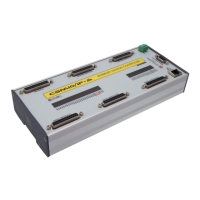www.cs-lab.eu
CS-Lab s.c. | CSMIO/IP-A 6-axis CNC controller. Manual tunning
5. Final steps
1) Gradually increase the acceleration to the assumed value while checking the graph for the "Mkit Following
Error" value. If the "Mkit Following Error" value increases to an unacceptable level, try the tuning of the
PID regulator of the CSMIO/IP-A controller position again. If the re-tuning does not help, the drive has
reached its end of life, and you should accept the lower acceleration value than assumed.
2) Finishing the process of manual PID regulator tuning of CSMIO/IP-A controller position, you cannot forget
to configure the target value of the "Error Alarm Threshold" parameter. This value cannot be too high
because in the event of a failure of any of the key components of the axis drive system, it may pose a
threat, and in turn, the too low value may cause false alarms. As a rule, the "Error Alarm Threshold" is
determined by multiplying 3 or 4 times the maximum recorded "Mkit Following Error" while the axis
moves at the maximum assumed speed. This method of determining the "Error Alarm Threshold" value
is universal and works well in any situation.
3) After a successful manual tuning process, we should thoroughly test the CNC machine, and especially the
operation of servo drives, in the broadest possible range of conditions in which they will work. These are
light and heavy loads and low and high ambient temperatures. We mention it because you should re-
member that a properly tuned servo drive is a servo drive that works as precisely and stable as possible
under all conditions.
4) After a month or two, you should check if a repeated tuning of the PID regulator of your CSMIO/IP-A
controller position is not required. This is usually necessary only for CNC machines that have not been
used for a long time because of flushing out thickened or dried grease or oil by their central lubrication
system. This results in a lighter axis operation and a lower value of parameters described in this manual.

